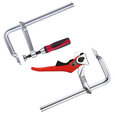Types of Clamps
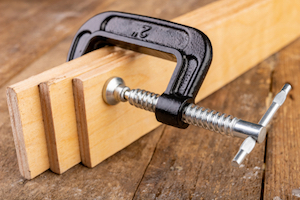
Figure 1: A C-clamp used while gluing wood planks together.
A clamp firmly holds two or more objects together, preventing them from moving or slipping while work is being performed. They are an essential tool for various applications, from woodworking to metalworking, automotive repair, and construction. Many types of clamps are available, each designed to perform specific functions and suit different materials and applications. This article explores the various types of clamps and their features, benefits, and typical uses.
Table of contents
View our online selection of screw clamps!
What is a clamp?
A clamp is a tool that securely holds and affixes objects or materials in place by applying a compressive force. A clamp's specific design and operation vary depending on its intended use. Generally, it consists of a pair of jaws, or pads brought together by a threaded screw or lever mechanism. The jaws of a clamp may be lined with soft materials, such as rubber or plastic, to prevent damage or slipping of the clamped material. Clamps may also incorporate additional features, such as pivoting jaws, swiveling bases, and quick-release mechanisms, to enhance their functionality and ease of use.
Types of clamps
This section explores the various types of clamps in detail, focusing on their specific applications and how they work. Clamps are available in various sizes and styles to suit a wide variety of applications, and many feature adjustable jaws and other design features to make them more versatile and user-friendly.
Hand clamps
As the name suggests, a hand clamp is hand-operated. It's designed to hold a workpiece during assembly, welding, machining, and inspection. Popular examples include:
Spring clamp
A spring clamp (Figure 2) uses spring tension to hold objects in place. The clamp consists of two pivoting jaws held together by a spring. To use the clamp, squeeze its handles together to open the jaws and place the object between them. The spring tension then holds the object securely in place. Beyond woodworking and metalworking, spring clamps are also useful for holding things like tarps, fabrics, and papers in place, making them a suitable tool for photographers and artists. They are inexpensive, easy to use, and can be found in various sizes and strengths to suit a wide range of applications.
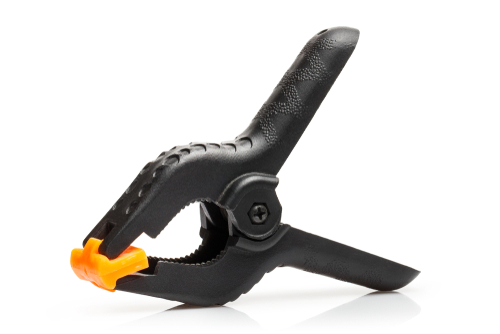
Figure 2: A spring clamp
Miter clamp
A miter clamp is specifically designed for woodworking and other crafts involving cutting and joining mitered corners. The clamp typically consists of two metal plates that are joined by a screw mechanism, which allows the adjustment of the angle of the plates to match the angle of the mitered corner.
Miter joints can be used to hold everything from picture frames to furniture together, and they are particularly useful for making angled cuts in materials like crown molding and baseboards. To use a miter clamp, first fit the two pieces of wood together at the correct angle and then place the clamp over the joint. Then, adjust the plates to tighten the clamp, securely holding the pieces of wood in place while the glue dries.
Quick action clamp
A quick action clamp (Figure 3) has a long bar with two padded jaws on each side; one jaw moves along the bar, and the other is stationary. The clamp's handle is a trigger that moves the mobile jaw closer to the stationary jaw. A lever on the handle allows the moveable jaw to quickly slide across the bar and adjust the distance between the two jaws. Use the lever to get the jaws to approximately the correct distance apart, place the jaws around the workpiece, and then squeeze the trigger to tighten the clamp further. Some quick-action clamps are designed to transform into spreaders by changing the position and orientation of the stationary jaw.
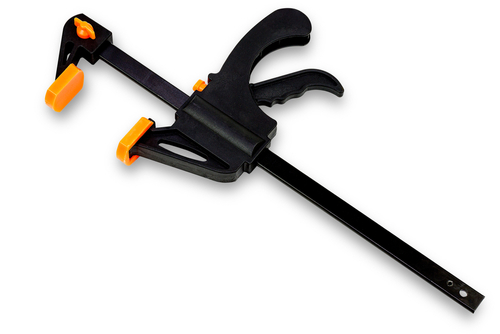
Figure 3: A quick action clamp
C-clamp
A C-clamp (Figure 1) is shaped like the letter "C." The clamp has a flat base, a screw mechanism, and a jaw that can be adjusted to hold objects of different sizes and shapes. C-clamps operate similarly to screw clamps. Using a c-clamp, first position the object to be clamped between the flat base and the jaw, then tighten the screw to hold the object securely in place. One advantage of a c-clamp is that it can be used in tight spaces where other clamps may not fit.
F-clamp
An f-clamp is a type of screw clamp that operates similarly to a c-clamp but has a wider opening.
Screw clamp
A screw clamp (Figure 4) uses a threaded screw to apply pressure and hold objects in place. The clamp typically consists of two flat jaws joined together by a screw mechanism. To use the adjustable screw clamp, place the object between the jaws and then tighten the screw to apply pressure and hold the object in place.
One advantage of screw clamps is that they can provide a very strong and secure hold on objects, making them useful for applications with a lot of pressure or force. However, they can also be more time-consuming than other clamps since they require the screw to turn to adjust the pressure. Additionally, they can be more difficult to use in tight spaces since the screw mechanism can make it hard to position the clamp exactly where needed.
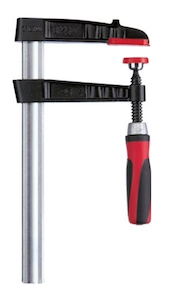
Figure 4: An f-clamp is a type of screw clamp
Locking clamp
A locking clamp uses a cam mechanism to provide a variable, adjustable clamping force. A cam mechanism is a machine part that transfers rotary motion into linear motion. The cam mechanism of a locking clamp is operated by a sliding handle, which controls the movement of the jaws and the amount of clamping force applied. Locking clamps come in various types, such as straight-jaw, curved-jaw, and needle-nose. They can be used for various applications, including welding, construction, and automotive repair.
Mechanical clamps
Mechanical clamps are simple mechanisms that use four primary components to hold material. These include a toggle handle, clamping arm, linkages, and a base. These devices use mechanical force and are independent of external energy sources.
Common mechanical clamps include:
Bench clamp
One type of a table clamp is a bench clamp, which is mounted to a workbench or table. The clamp consists of a flat base secured to the workbench and a pivoting jaw that can be adjusted to hold objects of different sizes and shapes. Because they are mounted to a bench, bench clamps are more secure than other clamps.
Edge clamp
An edge clamp holds objects along their edges rather than their faces. These clamps have three separate screws that allow the user to control the position of the clamp in two axes, making it an ideal tool for tasks such as holding down parts for butt-welding or gluing together an assembly.
Lifting clamps
The following clamps can be used for lifting purposes:
Vertical plate lifting clamp
A vertical plate lifting clamp is used in industrial settings for gripping and lifting large, heavy steel plates in a vertical orientation. The clamp has a pair of jaws that open and close using a screw mechanism or hydraulic power and apply pressure to the plate with a series of teeth or gripping elements. Vertical plate lifting clamps are mostly used in applications such as shipbuilding, construction, and heavy machinery manufacturing, where the ability to lift and manipulate large plates is critical to the manufacturing process.
Locking chain clamp
Locking chain clamps (Figure 5) consist of a chain that loops around the object(s) to be moved, with each end of the chain attached to a gripping mechanism. The gripping mechanism utilizes a cam or wedge system to apply force to the chain, which results in a secure and adjustable hold on the object. Locking chain clamps are common in the rigging and lifting of heavy machinery or equipment, as well as in construction and metalworking applications. These clamps excel at lifting objects with awkward or irregular shapes.
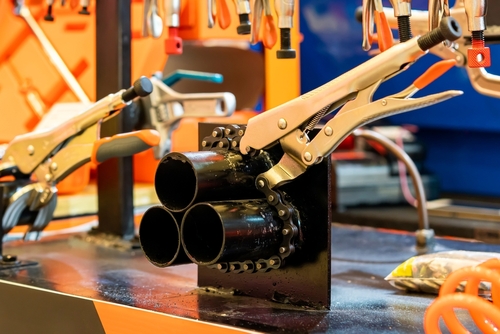
Figure 5: A locking chain clamp
Beam clamp
A beam clamp attaches and secures a load-bearing structure, such as a beam or pipe, to another structure, such as a support bracket or building frame. Made of durable materials like steel or aluminum, a beam clamp employs various locking mechanisms, including set screws, jaws, pin arrangements, and spring-loaded mechanisms, to ensure a secure connection.
Pneumatic and hydraulic clamps
Hydraulic and pneumatic clamps use fluid pressure to generate and maintain the clamping force. Hydraulic clamps use oil or other hydraulic fluids to create pressure, while pneumatic clamps use compressed air or gas.
Standard pneumatic clamp
A standard pneumatic clamp uses a pneumatic cylinder to clamp a workpiece. The clamping force is controlled by the air pressure applied to the cylinder, which compresses a spring, allowing the clamp to close. Standard pneumatic clamps are more suitable for durable materials, so a precise clamping force is unnecessary.
Pneumatic power clamp
A pneumatic power clamp uses a closed-loop feedback system and a proportional valve to precisely control the clamping force. This type of clamp is suitable for fragile workpieces that may break if the clamping force is not carefully adjusted.
Hydraulic clamp
A hydraulic clamp employs the physical principles of fluid mechanics to generate and transmit force. It consists of a hydraulic cylinder, typically powered by a pump, which drives a piston or plunger to apply clamping pressure to the workpiece. Hydraulic clamps are widely used in high-force industrial applications, particularly metalworking, providing precise and reliable clamping force with minimal operator intervention.
Pipe and cable clamps
Pipe and cable clamps secure and support pipes, cables, conduits, and other similar components in industrial and construction applications.
Standard pipe clamp
The standard pipe clamp (Figure 6) attaches and secures pipes, tubes, or other cylindrical objects to a stationary structure, such as a wall or ceiling. This clamp consists of two semi-circular jaws connected by a threaded rod and tightened with a screw, which compresses the jaws together to grip the clamped object.
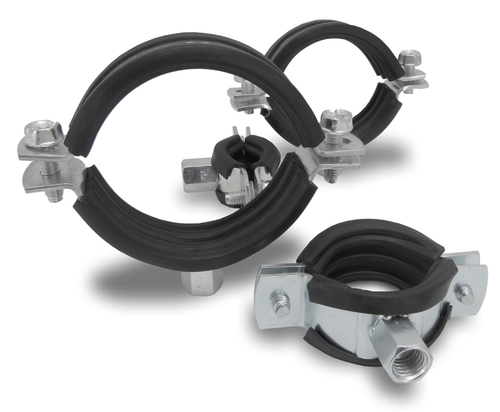
Figure 6: Pipe clamps
Wire rope clamp
A wire rope clamp is used to secure the ends of wire rope. It consists of a U-shaped bolt, a saddle, and two nuts. It is designed to apply pressure to the wire rope and grip it securely, while also distributing the load across the clamp. Wire rope clamps are commonly used in industries such as mining, construction, and marine, where they attach and secure ropes, cables, and other components in harsh and demanding environments.
Ground clamp
A ground clamp is an electrical component that establishes a low-impedance connection between a conductor and a grounding electrode, typically a metal rod or plate buried in the earth. Ground clamps securely grip the conductor, ensuring a reliable electrical connection that effectively dissipates electrical energy into the earth, preventing electrical hazards and protecting equipment from damage. Ground clamps are used in various applications, including power distribution systems, telecommunications networks, and industrial facilities.
Material handling clamps
Material handling clamp is an umbrella term for devices that facilitate the movement of large loads, from raw materials to finished products. Common devices in this category include:
Sheet metal clamp
Sheet metal clamps operate similarly to locking clamps. However, the sheet metal clamp's jaws are wider, making them more effective for holding sheet metal.
Dimide clamp
A Dimide clamp has a C-shaped body with a threaded bolt running through its center that turns to move the jaws together or apart. It operates similarly to a c-clamp but can apply significantly more clamping force for high-demand applications.
Marman clamp
A marman clamp is used to connect two components in an aerospace system, typically to secure and maintain the integrity of fluid or gas flow. A marman clamp has a specialized split-ring construction, allowing for a high degree of adjustability and adaptability to variations in component size and shape.
Power clamp
Power clamps are electromechanical devices with a combination of electric motors, gears, and control systems to automatically and securely grip objects with high force and precision. The clamping force generated by these devices can be precisely controlled through the use of advanced sensors and feedback systems, which can ensure accurate positioning and prevent damage to delicate or fragile materials. These clamps are often integrated into robotic systems and industrial machinery to facilitate automated production and handling processes.
Scissor clamp
A scissor clamp grasps and secures objects with a high degree of precision and force. This tool has two opposing metal blades that are hinged at a central pivot point. One or both of the blades has serrated teeth to enhance the grip. A lever or handle operates the clamp to open and close the blades in a scissor-like motion. Scissor clamps are commonly used in industrial and laboratory settings for tasks such as holding and manipulating delicate or hazardous materials.
Other Common Work Clamps
Picture frame clamp
A picture frame clamp is a woodworking tool that secures the corners of a frame during the gluing process. This device has an adjustable clamping mechanism, which a screw or lever operates. The mechanism applies pressure to the frame's corners.
Sash clamp
A sash clamp is a woodworking tool that has a long, narrow beam made of sturdy material, such as steel or aluminum, to provide significant clamping pressure. This beam is supported by a pair of jaw assemblies, which are attached to a movable bar that can be adjusted along the beam's length. Sash clamps are used in furniture construction and other woodworking applications to hold two or more pieces of material together while the glue dries or when performing intricate joinery.
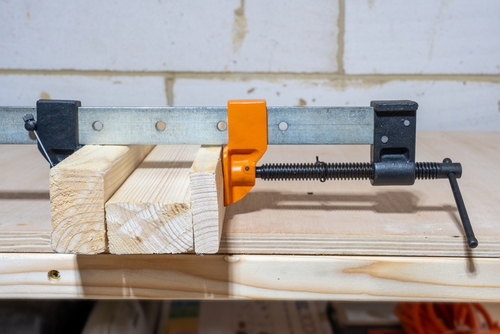
Figure 7: A sash clamp
Hose clamp
A hose clamp secures a flexible and compressible hose onto a fitting or a barb. It consists of a circular metal band, often made of stainless steel, with a worm gear or a screw mechanism that works to adjust the diameter of the band and tighten it around the hose. Hose clamps are essential components in a wide range of industrial, automotive, and plumbing applications, where they are used to prevent leaks, ensure a tight seal and maintain the integrity and safety of the fluid or gas-carrying system.
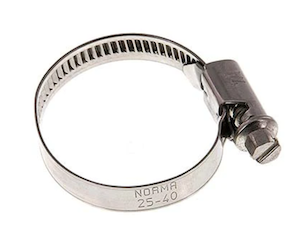
Figure 8: A worm gear hose clamp
Cabinetry clamp
A cabinetry clamp holds cabinet pieces together during the assembly process. The clamp has a sliding jaw that applies a significant amount of force to the pieces being joined. Cabinetry clamps are available in various types, including bar clamps, pipe clamps, and parallel clamps, each with unique characteristics and applications.
Kant-Twist clamp
The Kant-Twist clamp clamps and holds workpieces in place during machining, welding, or other industrial processes. This specialized clamp has a unique design that uses the combination of a cam, lever, and locking mechanism to provide a powerful clamping force with minimal effort. The cam and lever work together to provide a rapid clamping action that secures the workpiece quickly and efficiently, while the locking mechanism ensures that the clamp remains securely in place during the machining process.
Web clamp
A web clamp is utilized in woodworking and carpentry for securing large workpieces during the assembly process. This tool is specifically designed to apply clamping pressure to the edges of the workpiece, thereby ensuring a uniform and stable grip across the entire surface. The web clamp has a series of pivoting jaws that can be adjusted and locked in place to accommodate various thicknesses of material. The clamping force is typically provided by a mechanical mechanism, such as a screw or ratchet, and is capable of generating a high level of pressure, making it ideal for use in heavy-duty woodworking applications.
FAQs
What are the different types of metal screw clamps?
There are various types of metal clamps, such as F-clamps that have sliding jaws, G-clamps that have threaded screws, deep throat clamps with longer reach, and trigger clamps with a release trigger.
Do clamps have a holding capacity?
Clamps have different holding capacities. Users should verify the maximum force that particular devices can resist safely while in a locked position to prevent inefficient clamping and damage.




